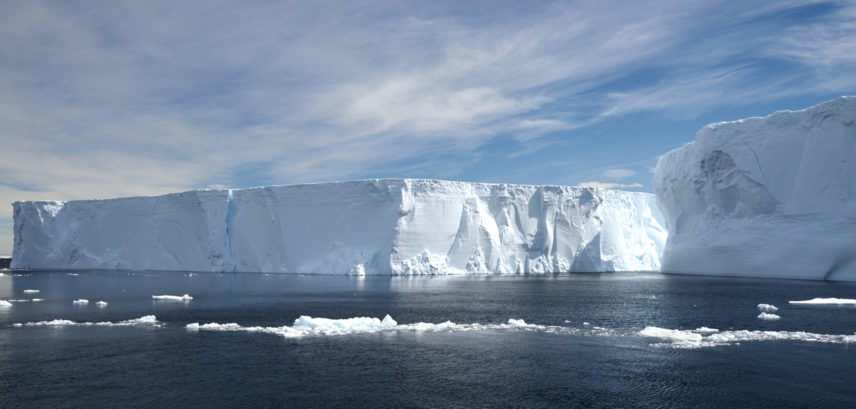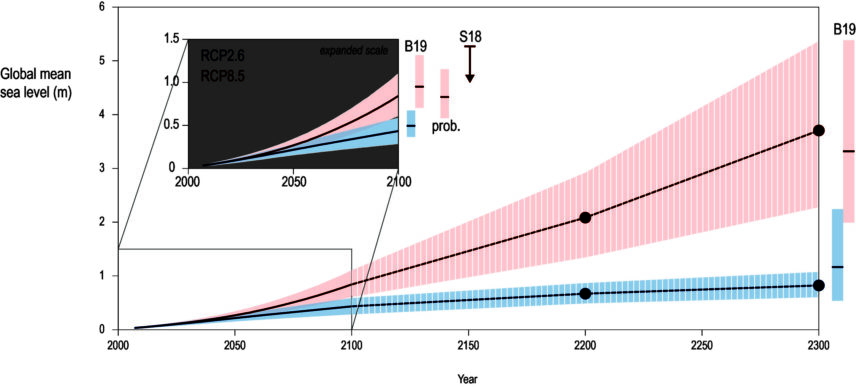Article begins
Antarctic ice looms. Literally. Much of the ice edge of Antarctica is made up of massive cliffs, its size and expanse almost incomprehensible from photographs. The Ross Ice Shelf, for example, is more than 370 miles long and stands starkly up to 160 feet high, a barrier into the continent. It also looms as a threat to coastlines, the settlements built there, and the livelihoods that people make on the ocean’s edge.
The scientists I work with are trying to read the history and future of the world from the ice. Anthropology is a field science too, so these Antarctic geologists, biologists, ecologists, glaciologists, geochemists, and I share the impulse to go out there, to learn by experience, to witness the largest wilderness on Earth.
Out on the ice, the physical scientists and I mused over different things. Geologists were mountaineers who meditated over the rocks they climbed on. Biogeochemists made new discoveries at meltwater ponds that ecologists had camped alongside for decades, but with fresh eyes and different disciplinary training. I took pictures of the cards we used to size and shape different ice crystals, fascinated by the attempts to standardize nature and help us translate all discoverable ice from a little sheet of black plastic. My friends fell asleep in their tents; I stayed up in my yellow tent in the bright Antarctic night, writing notes on conversations, things I learned, and puzzles in my field notebook. A central puzzle was how this grounded, adventurous fieldwork turned into understandings of the ice across time, including the future. To understand that, I had to expand my inquiries beyond the field sciences and into climate modeling and, in turn, the ways that scientists explain and interact with the climate crisis at hand, particularly in interactions with climate decision makers at events like the meetings of the United Nations Framework Convention on Climate Change (UNFCCC). Although the evidence of anthropogenic climate change is clear, predicting the pace and timeframe of future climate impacts poses a challenge for scientists—how to communicate the certainty of change in light of some outstanding scientific questions, such as the future of Antarctic ice.

After spending a year and a half with Antarctic field scientists, I realized I needed to learn more about ice sheet modeling in order to understand the larger story that field glaciologists were contributing to. Their boreholes, satellite altimetry, and coastal excursions were helping write more accurate code for one of the frontiers of climate modeling—the marine West Antarctic Ice Sheet (WAIS). Fundamentally unstable and interacting with the warming ocean from its grounding line and underside as well as the warming air, the West Antarctic Ice Sheet has been a specter of potential global sea level rise since glaciologist John Mercer’s research in the 1960s, which culminated in the powerfully titled Nature article “West Antarctic Ice Sheet and CO2 Greenhouse Effect: A Threat of Disaster” (1978). Several decades of research and dozens of experts neutralized the specter of threat for quite a while: conventional wisdom when I began learning about Antarctic science in the mid-2000s was that the ice sheets were stable for at least the next several centuries, and the Antarctic was gaining mass through snowfall, slightly lowering global sea levels.
In 2008, understanding the present ice sheet changed immediately with satellite observations of the entirety of Antarctica from NASA and the German Aerospace Center, Deutsches Zentrum für Luft und Raumfahrt’s satellite, named Gravity Recovery and Climate Experiment (GRACE). For the first time, observers were able to view the continental ice sheet as a singular entity, with all of its flow, accumulation, thinning, and spreading. The ice sheet, we learned, was losing mass (Rignot et al. 2008; Chen et al. 2009) and the pace of ice loss had accelerated in the first decade of this century (Velicogna 2009). The models had not accurately depicted the behavior of the ice sheet and the threat of disaster edged closer.
I have developed a professional affinity for listening to scientists talk about the ice. The reverence, the technical detail, the joy in helping solve a fascinating physics puzzle, and the guarded urgency that tacks between their disciplinary reticence and their close-up understanding of the threat at hand.
Scientists tend not to jump to worst-case scenarios; skepticism, reticence, and modesty are part of their disciplinary dispositions. My colleagues and I call this “erring on the side of least drama,” or ESLD (Brysse et al. 2013) [see also Hansen 2007; Mann 2012; Oreskes and Conway 2010; Schneider 2009]. The satellite images helped field glaciologists identify sites where they could ground-truth the remote observations. That the Antarctic ice sheets were currently losing mass held, and in some areas, notably the Pine Island Glacier region, it became apparent that the ice loss was accelerating.
The discovery posed an epistemic challenge to develop ways to counter the regular underpredictions that scientists were finding. It wasn’t news that the West Antarctic Ice Sheet was difficult for glaciologists to understand; in 1976, the materials scientist Johannes Weertman deemed the ice sheet “glaciology’s grand unsolved problem.” As more time unspooled, it became clear that the conventional wisdom, including that generations of ice sheet models, were not up to the task of an ice sheet showing signs of increasing dynamical processes. To try to account for this, researchers used methods beyond ice sheet modeling, including semi-empirical calculations (trying to calculate not just a rate for sea level rise, but one that captures the rapid disintegration of the ice sheets) or expert elicitation (a controversial practice that asks scientists to provide their expert “gut” judgements). And of course, the new observational data opened up space for modelers to continue to work on solving questions such as how to model the marine grounding line and a more recently described phenomenon called marine ice cliff instability (MICI), which posits that high, sheer ice cliffs could disintegrate rapidly.
Questions around MICI have buzzed around the ice sheet community over the past few years, since ice sheet modelers Robert DeConto and David Pollard wrote about it in a 2016 Nature article. Compared with previous assessments of how much sea level rise the Antarctic ice sheets contribute to global sea level rise, the DeConto and Pollard numbers were staggeringly high, estimating 1 meter of sea level rise by 2100 and 13 meters by 2500, “if emissions continue unabated.”
Immediately a debate flourished over whether these numbers were alarmist—too high, too scary, and not supported by other research—or simply alarming. The study was picked up with interest by Antarctic and climate environmental advocates. It provided a new, more urgent narrative about the fate of human civilization and the suffering and expense we face to deal with the damages we have begun.
Attending the 25th Conference of Parties (COP25) of the UNFCCC in December 2019, I ran into an Antarctic policy friend who told me that Rob DeConto was presenting at the Cryosphere Pavilion—a new initiative encouraged by the Chilean government, who wanted the COP to bring more attention to Antarctica—later that day. The UNFCCC meetings are not just UN policy meetings but a climate conference with dozens of media, science, political, outreach, and cultural events held concurrently over two weeks. Always a frenetic environment, COP25 was particularly dynamic because the Chilean government had cancelled their hosting of the meeting due to the protests in Santiago just a few weeks ahead of the opening plenary. Spain had whipped together a COP in Madrid.
I have developed a professional affinity for listening to scientists talk about the ice. The reverence, the technical detail, the joy in helping solve a fascinating physics puzzle, and the guarded urgency that tacks between their disciplinary reticence and their close-up understanding of the threat at hand. DeConto delivered. And as the co-author of the most controversial Antarctic ice sheet article since the last Intergovernmental Panel on Climate Change (IPCC) assessment reports were published, he did not shy away from reflecting on the impact of his work.

The research with Pollard incorporated the IPCC’s Representative Concentration Pathways (RCP) into their ice sheet models, comparing the sea level rises associated with the various greenhouse gas emission scenarios that the IPCC uses to compare global circulation models. Their results—with their model including MICI for the first time—showed a meter of sea level rise coming from Antarctica by 2100, which was considerably higher than the likely range of 0.26–0.82m projected in IPCC’s Fifth Assessment Report (2013). However, DeConto told us in the audience that RCP2.6, a scenario that assumes rapid, successful global efforts to bring down carbon emissions worldwide, greatly reduces the risk of such a large, quick rise in sea level. He noted a “role for policy,” emphasizing that our climate future can still be adjusted through swift and serious policy action.
To my surprise, DeConto then launched into a frank discussion about how the article that resulted from their research was not included in the 2019 IPCC Special Report on the Ocean and Cryosphere in a Changing Climate (SROCC), an assessment meant to update world decision makers on exactly the subject matter Pollard and DeConto had been working on. He, and the expert community he is aligned with, had realized that in their models “the climate forcing went too warm, too fast.” DeConto and Pollard immediately went to work fixing the issue but as he put it, the quantification “was not there” in time for SROCC.
Even with the absence of the DeConto and Pollard 2016 results, the sea level rise projections in the 2019 SROCC are monumental in scope. For the first time in IPCC’s history, the top of the likely range is greater than a meter of sea level rise by 2100. Also acknowledging the decades of IPCC history, SROCC expanded the time horizon beyond 2100, projecting out to 2300. This allows, for example, coastal city planners to consider infrastructure with a radically different coastline (or retreat, among other options).
That the Antarctic ice sheets were currently losing mass held, and in some areas, notably the Pine Island Glacier region, it became apparent that the ice loss was accelerating.
DeConto showed us a slide with his new numbers. As the work is still under review, he asked us not to take pictures. He and Pollard had decided to run the corrected model not with RCPs but with the collection of nationally determined contributions (NDCs) that countries submit as their pledge to the Paris Agreement. These NDCs are meant to be iterative, updated every five years as part of a UNFCCC process called the Global Stocktake. It’s not a spoiler alert to note that the first round of NDCs is not sufficient to solve the climate crisis.
DeConto went further, stating that “even geoengineered CO2 drawdown won’t save the [West] Antarctic ice sheet if action is delayed.” And in his concluding remarks, he said that, using human societal timescales, we should consider all ice lost from Antarctica permanent at this point.
The human-scale permanence of Antarctic ice loss means that Antarctica is transformed along with far-flung coastlines and the people and other living things there. Climate change has decidedly become a crisis, a real time threat that people are living and dying with, experiencing now, and suffering from. Although political inaction could be framed as a need for more robust scientific understandings of the changes at hand and in the future, this framing is now untenable and increasingly ridiculous in the face of mounting climate impacts, extreme events exacerbated by climate change, and a scientific consensus that is among the most robust ever formed.
As an anthropologist closing in on two decades of working with climate scientists, I have had the opportunity to observe how field scientists, remote sensing experts, and modelers observe our changing planet and predict a tumultuous environmental future. Even using cautious scientific language, researchers are managing to express the urgency of these changes and the consequences we face as we fail to act.

